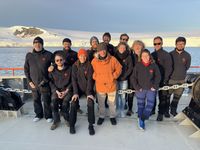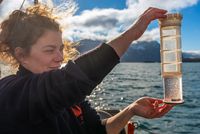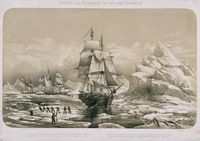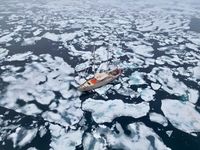In summer 2025, the Musée National de la Marine highlights explorer Jean-Louis Étienne’s schooner Persévérance, setting out to cross the legendary Northwest Passage. A remarkable human and scientific adventure at the heart of today’s climate and oceanographic challenges.
The schooner Persévérance, heir to great explorations
 Enlarge image : Crew of the schooner Persévérance gathered on deck during the Arctic expedition.
Enlarge image : Crew of the schooner Persévérance gathered on deck during the Arctic expedition.
The Musée National de la Marine pays tribute to explorer Jean-Louis Étienne’s schooner Persévérance, which will set out in August 2025 to cross the legendary Northwest Passage. From Baffin Bay, in the eastern Canadian Arctic, to the Bering Strait between Alaska and Russia, this voyage follows in the footsteps of centuries of maritime conquest. For over 400 years, this passage has been the scene of adventure stories, shipwrecks, tragedies, scientific discoveries, and geopolitical stakes.
The challenge of the Northwest Passage
In 1845, British navigator Sir John Franklin vanished in these icy waters with 129 men aboard the Erebus and the Terror, crushed by the relentless ice. It was not until Norwegian explorer Roald Amundsen, after three long winters between 1903 and 1906, that the route was successfully crossed.
In August 2025, Persévérance, departing from Greenland, will attempt to reach the Pacific Ocean via this legendary passage. Even for a polar vessel built to withstand ice, the expedition is daunting: despite summer conditions and global warming, pack ice can still obstruct the narrowest straits.
A scientific and ecological mission
 Enlarge image : Researcher on board the schooner Persévérance holding a seawater sample collected for scientific analysis.
Enlarge image : Researcher on board the schooner Persévérance holding a seawater sample collected for scientific analysis.
Beyond human adventure, Persévérance is a state-of-the-art scientific vessel equipped with a wide range of high-precision sensors. These instruments continuously measure energy consumption, ocean and atmospheric data, transmitted in real time to researchers on land. On board, a crew of professional sailors specialized in electronics and computing works alongside oceanography engineers.
The mission will include an acoustic inventory of marine mammals, permanent analysis of the atmosphere, seawater, and ice, as well as a better understanding of the ocean’s role in CO₂ absorption and global climate regulation.
After the Northwest Passage, Persévérance will head to Antarctica between January and March 2026. In the Ross Sea and Dumont d’Urville Sea, the schooner will collect essential data to support the creation and development of Antarctic Marine Protected Areas.
Focus on two objects featured in the exhibition
In this focus exhibition, set up in the Espace d’actualité (free access) of the Musée National de la Marine, visitors can discover 19th-century depictions of the Northwest Passage before its discovery, along with scientific instruments used for polar oceanographic studies, and photograph of the shooner PERSEVERANCE. These objects highlight both the memory of historic expeditions and the contemporary commitment of Jean-Louis Étienne and his team aboard the schooner Persévérance.
Prince Albert and Two American Schooners
 Enlarge image : 19th-century lithograph showing the ship Prince Albert and two American schooners trapped in Arctic ice during expeditions in search of the Northwest Passage.
Enlarge image : 19th-century lithograph showing the ship Prince Albert and two American schooners trapped in Arctic ice during expeditions in search of the Northwest Passage.
Lithograph on paper, 19th century
Among the many expeditions launched in search of the Northwest Passage, several never returned, including that of Sir John Franklin in 1845. For years, sailors tried to find traces of the lost expedition. One of them, French naval officer Joseph-René Bellot, embarked on the Prince Albert and documented his journey through drawings and lithographs. In this view, the ship has been pushed into an ice crevasse by strong winds, and the crew attempts to tow it back into deeper waters.
The schooner Persévérance drifting in the Northwest Passage
 Enlarge image : Photograph of the schooner Persévérance drifting in the Northwest Passage in August 2025, equipped for ocean and climate research.
Enlarge image : Photograph of the schooner Persévérance drifting in the Northwest Passage in August 2025, equipped for ocean and climate research.
Digital photograph, August 2025
Designed for eco-responsible navigation in extreme environments, the schooner Persévérance consumes only one ton of fuel per day—half that amount when under sail—compared to an average of 25 tons for ships of similar size. While drifting, the vessel continuously collects data on water (temperature, salinity, pH, oxygen, CO₂), marine life (plankton studies, acoustic monitoring of marine mammals), and the atmosphere (temperature, pressure, wind, humidity), shared with international climate research laboratories.
Practical information
From September 4, 2025, to october 6, 2025
Open daily from 11:00 a.m. to 7:00 p.m., except on Tuesdays.
Late-night opening on Thursdays until 10:00 p.m.
Last admission: 1 hour before closing.
Espace d’actualité
Palais de Chaillot
17 Place du Trocadéro
75016 Paris
Free entrance
![]()



